Calibration Procedure to Test the Effects of Multiple Influence Quantities on Low-Power Voltage Transformers
Abstract
:1. Introduction
2. Low-Power Voltage Transformers
3. Calibration Procedure
3.1. Frequency Tests
3.2. External Field Tests
3.3. Temperature Tests
3.4. Combined Tests
- For the three frequencies described in Section 3.1 (49.5 Hz, 50 Hz, and 50.5 Hz);
- For the three frequencies when the electric field is acting as described in Section 3.2.
- Temperature + electric field. For the 11 measurement points of the thermal cycle, and are computed when the electric field acts on the LPVT (22 tests of 100 measurements each).
- Temperature + frequency. For the 11 measurement points of the thermal cycles, and are computed for the three frequencies of interest (33 tests of 100 measurements each).
- Frequency + electric field. For the three frequencies of interest, and are computed when the electric field is acting on the LPVT (6 tests of 100 measurements each).
4. Experimental Case Study
4.1. Introduction
4.2. Measurement Setup
- An Agilent 6813B power source. It provided the sinusoidal voltage, at the desired frequency, to the step-up transformer. Between the power source and the step-up transformer an isolating transformer with ratio 1:1 was placed to electrically separate the low and the medium voltage.
- The 0.1/15 kV step-up transformer. It took the low voltage (LV) from the isolating transformer and provided the rated voltage for the LPVTs, which for all of them was kV.
- A TVM-24-1C reference voltage transformer. It featured a selectable load of 0.25 or 1 VA, an accuracy class of 0.1, and nominal ratio of 20/0.1 kV. The transformer wa under metrological confirmation and was used as a reference for the accuracy performance evaluation of the three LPVTs under test. The transformer was used in series to a 11.0024:1 resistive divider to fit with the acquisition system adopted for the tests. The resistive divider was characterized by means of a Fluke 6105a Calibrator; from the results it emerged that the divider introduces a negligible phase displacement (compared to the quantity measured) and that it has a ratio of 11.0024 with a standard deviation of the mean of .
- A thermostatic chamber. Used for the temperature vs. accuracy tests, it was possible to vary its temperature in the range 5–70 °C.
- An acquisition system consisting of a NI-cDAQ 9174 and one NI-9239 data acquisition board (DAQ). The NI-9239 board is a 24-bit acquisition system with four channels at V input, 50 kSa/s per channel of maximum acquisition rate, and gain and offset errors of and , respectively.
- The three LPVTs under test. As mentioned above, they are referred to as A, B, and C and their main characteristics are summarized in Table 1. In particular, the table contains the type of each LPVT, their accuracy class (AC), and their rated primary and secondary voltage values, and , respectively. Note, that all LPVTs have the same accuracy class; hence, during the results evaluation a direct comparison is possible. Furthermore, the three LPVTs share very similar that fits with the full scale of the adopted acquisition board.
4.3. Experimental Tests and Results
4.3.1. Tests vs. Frequency
4.3.2. Tests vs. Electric Field
4.3.3. Tests vs. Temperature
- Technical limits of the thermostatic chamber adopted;
- Difficulties in the market to find thermostatic/climatic chambers with sufficient space to contain the MV equipment and to guarantee the distances for the electrical safety;
- A test performed at 5 °C, which is the average winter temperature in Italy [47], would have provided useful information: (i) what happens to Italian LPVTs working at their lowest average temperature; (ii) if anomalous behavior is reported at 5 °C, then at −5 °C the situation is even worse.
- As expected, the tested frequency values do not affect the LPVTs’ accuracy;
- The electric field instead, is a more disturbing quantity that influences the capacitive LPVT more, varying its up to the allowed limits. However, none of the and of the tested LPVTs exceeded the accuracy limits fixed by the accuracy class.
- The air temperature appears to be a really stressing influence quantity for all the tested LPVTs, no matter the diverse technologies used to manufacture them. Furthermore, the high temperature is critical for LPVTs B and C, while the low temperature is dangerous for A. This resulted in exceeding the accuracy limits in the different conditions mentioned, hence not guaranteeing the correct operation of the devices. Such a conclusion affects both the DSOs and the final costumers, depending on the sign of the and variations. In other words, the sign of the variation can make the DSOs and the customers save or pay money that they do not deserve.
4.3.4. Tests vs. Two Influence Quantities
- Overall, it was demonstrated in Section 4.3.1 that the frequency does not significantly affect the performance of the LPVTs; this behavior is confirmed also when such quantity is combined either with electric field or temperature (and for both and ). In fact, these last two influence quantities are far more critical than the frequency;
- Temperature has emerged as the main critical quantity. However, its combination with the electric field resulted in two main behaviors. One, where and worsened or were not affected at all at ambient or high temperatures. Another, where and improved by the presence of an electric field superimposed to the temperature effect, at low temperature. Furthermore, the beneficial effect of the electric field at 5 °C resulted in returned within the accuracy limits when they exceeded the effect of the temperature.
4.3.5. Tests vs. All Three Influence Quantities
5. Conclusions
Author Contributions
Funding
Conflicts of Interest
References
- IEC 61869-1: 2010. Instrument Transformers—Part 1: General Requirements; International Standardization Organization: Geneva, Switzerland, 2010. [Google Scholar]
- IEC 61869-2: 2012. Instrument Transformers—Part 2: Additional Requirements for Current Transformers; International Standardization Organization: Geneva, Switzerland, 2012. [Google Scholar]
- IEC 61869-3: 2011. Instrument Transformers—Part 3: Additional Requirements for Inductive Voltage Transformers; International Standardization Organization: Geneva, Switzerland, 2011. [Google Scholar]
- IEC 61869-6: 2016. Instrument Transformers—Part 6: Additional General Requirements for Low-Power Instrument Transformers; International Standardization Organization: Geneva, Switzerland, 2016. [Google Scholar]
- IEC 61869-10: 2018. Instrument Transformers—Part 10: Additional Requirements for Low-Power Passive Current Transformers; International Standardization Organization: Geneva, Switzerland, 2018. [Google Scholar]
- IEC 61869-11: 2018. Instrument Transformers—Part 11: Additional Requirements for Low-power Passive Voltage Transformers; International Standardization Organization: Geneva, Switzerland, 2018. [Google Scholar]
- IEC 60044-7: 2000. Instrument Transformers—Part 7: Electronic Voltage Transformers; International Standardization Organization: Geneva, Switzerland, 2000. [Google Scholar]
- Faifer, M.; Laurano, C.; Ottoboni, R.; Toscani, S.; Zanoni, M. Characterization of voltage instrument transformers under nonsinusoidal conditions based on the best linear approximation. IEEE Trans. Instrum. Meas. 2018, 67, 2392–2400. [Google Scholar] [CrossRef]
- Alanzi, S.S.; Alayli, A.R.; Alrumie, R.A.; Alrobaish, A.M.; Ayhan, B.; Cayci, H. Establishment of an Instrument Transformer Calibration System at SASO NMCC. In Proceedings of the Conference on Precision Electromagnetic Measurements, Paris, France, 8–13 July 2018; pp. 1–2. [Google Scholar]
- Crotti, G.; Femine, D.; Gallo, D.; Giordano, D.; Landi, C.; Letizia, P.; Luiso, M. Calibration of current transformers in distorted conditions. In Proceedings of the 22nd World Congress of the International Measurement Confederation, Belfast, UK, 3–6 September 2018; p. 052033. [Google Scholar]
- Draxler, K.; Hlavacek, J.; Styblikova, R. Calibration of Instrument Current Transformer Test Sets. In Proceedings of the International Conference on Applied Electronics, Pilsen, Czech Republic, 10–11 September 2019; pp. 1–4. [Google Scholar]
- Yu, J.C.; Li, D.Y.; Li, J.; Li, H.; Li, Z.C. Design and validation of broadband calibration system for fiber—optical current transformers. In Proceedings of the International Conference on Clean energy and Electrical Systems, Nanjing, China, 27–29 June 2019; p. 012026. [Google Scholar]
- Kaczmarek, M.; Stano, E. Proposal for extension of routine tests of the inductive current transformers to evaluation of transformation accuracy of higher harmonics. Int. J. Electr. Power Energy Syst. 2019, 113, 842–849. [Google Scholar] [CrossRef]
- Tong, Y.; Liu, B.; Abu-Siada, A.; Li, Z.; Li, C.; Zhu, B. Research on calibration technology for electronic current transformers. In Proceedings of the International Conference on Condition Monitoring and Diagnosis, Perth, WA, Australia, 23–26 September 2018; pp. 1–5. [Google Scholar]
- Cayci, H.; Kefeli, T. A calibration system for electronic current transformers with analogue outputs. In Proceedings of the International Metrology Conference, Cairo, Egypt, 19–21 April 2010. [Google Scholar]
- Pasini, G.; Peretto, L.; Roccato, P.; Sardi, A.; Tinarelli, R. Traceability of Low-Power Voltage Transformers for Medium Voltage Application. IEEE Trans. Instrum. Meas.vol. 2014, 63, 2804–2812. [Google Scholar] [CrossRef]
- Crotti, G.; Gallo, D.; Giordano, D.; Landi, C.; Luiso, M. Non-conventional instrument current transformer test set for industrial applications. In Proceedings of the Workshop on Applied Measurements for Power Systems, Aachen, Germany, 24–26 September 2014; pp. 1–5. [Google Scholar]
- Crotti, G.; Gallo, D.; Giordano, D.; Landi, C.; Luiso, M.; Cherbaucich, C.; Mazza, P. Low cost measurement equipment for the accurate calibration of voltage and current transducers. In Proceedings of the International Instrumentation and Measurement Technology Conference, Montevideo, Uruguay, 12–15 May 2014; pp. 202–206. [Google Scholar]
- Mingotti, A.; Peretto, L.; Tinarelli, R.; Angioni, A.; Monti, A.; Ponci, F. Calibration of Synchronized Measurement System: from the Instrument Transformer to the PMU. In Proceedings of the Workshop on Applied Measurements for Power Systems, Bologna, Italy, 26–28 September 2018; pp. 1–5. [Google Scholar]
- Mingotti, A.; Peretto, L.; Tinarelli, R.; Angioni, A.; Monti, A.; Ponci, F. A Simple Calibration Procedure for an LPIT plus PMU System Under Off-Nominal Conditions. Energies 2019, 12, 4645. [Google Scholar] [CrossRef] [Green Version]
- Yao, W.; Zhang, Y.; Xu, Q.; Tang, J.; Hu, Y.; Lai, D. Study on Calibration Technology for Fast Pulsed Electrical Sensors. High Vol. Eng. 2019, 45, 814–819. [Google Scholar]
- Suomalainen, E.P.; Hallstrom, J. Experience with Current Transformer Calibration System Based on Rogowski Coil. In Proceedings of the Conference on Precision Electromagnet Measurements, Paris, France, 8–13 July 2018; pp. 1–2. [Google Scholar]
- Djokic, B.V. Improvements in the performance of a calibration system for rogowski coils at high pulsed currents. IEEE T. Instrum. Meas. 2017, 66, 1636–1641. [Google Scholar] [CrossRef]
- Paulus, S.; Kammerer, J.; Pascal, J.; Bona, C.; Hebrard, L. Continuous calibration of Rogowski coil current transducer. Analog Integrated Circuits and Signal Processing 2016, 89, 77–88. [Google Scholar] [CrossRef]
- Yan, Z.; Ren, X.; Ren, H.; Ding, W. Study on condensation of the moisture in current transformers with current flow considering sharp temperature decrease. In Proceedings of the International Conference on Measurement, Instrumentation and Automation, Guangzhou, China, 15–16 September 2012; pp. 322–327. [Google Scholar]
- Ma, X.; Guo, Y.; Chen, X.; Xiang, Y.; Chen, K. Impact of Coreless Current Transformer Position on Current Measurement. IEEE T. Instrum. Meas. 2019, 68, 3801–3809. [Google Scholar] [CrossRef]
- Velásquez, R.M.; Lara, J.V. Current transformer failure caused by electric field associated to circuit breaker and pollution in 500 kV substations. Eng. Fail. Anal. 2018, 92, 163–181. [Google Scholar] [CrossRef]
- Crotti, G.; Gallo, D.; Giordano, D.; Landi, C.; Luiso, M.; Modarres, M. Calibration of MV voltage instrument transformer in a wide frequency range. In Proceedings of the International Instrumentation and Measurement Technology Conference, Torino, Italy, 22–25 May 2017; pp. 1–6. [Google Scholar]
- Chen, Y.; D’Avanzo, G.; Delle, A.; Gallo, D.; Landi, C.; Luiso, M.; Mohns, E. Metrological performances of current transformers under amplitude modulated currents. In Proceedings of the Conference on Testing, Diagnostics and Inspection as a Comprehensive Value Chain for Quality and Safety, Berlin, Germany, 3–4 September 2019. [Google Scholar]
- Mingotti, A.; Peretto, L.; Tinarelli, R.; Mauri, F.; Gentilini, I. Assessment of Metrological Characteristics of Calibration Systems for Accuracy vs. Temperature Verification of Voltage Transformer. In Proceedings of the Workshop on Applied Measurements for Power Systems, Liverpool, UK, 20–22 September 2017; pp. 1–6. [Google Scholar]
- Mingotti, A.; Peretto, L.; Tinarelli, R.; Ghaderi, A. Uncertainty sources analysis of a calibration system for the accuracy vs. temperature verification of voltage transformers. J. Phys. Conf. Ser. 2018, 1065, 052041. [Google Scholar] [CrossRef] [Green Version]
- Goncalves, M.N.; Werneck, M.M. A temperature—independent optical voltage transformer based on FBG—PZT for 13.8 kV distribution lines. Measurement 2019, 147, 106981. [Google Scholar] [CrossRef]
- Li, Z.; Du, Y.; Abu-Siada, A.; Li, Z.; Zhang, T. A new online temperature compensation technique for electronic instrument transformers. IEEE Access 2019, 7, 97614–97623. [Google Scholar] [CrossRef]
- Parfenov, G.I.; Gotovkina, E.E.; Lebedev, V.D.; Smirnov, N.N.; Tyutikov, V.V. Development of a thermal self-diagnostics system for a digital current and voltage instrument transformer. In Proceedings of the IOP Conference Series: Materials Science and Engineering, Kislovodsk, Russian Federation, 1–5 October 2019. [Google Scholar]
- Wang, P.; Cheng, F.; Ping, L.; Shen, Z. Temperature characteristics of Rogowski coil current sensors. In Proceedings of the International Instrumentation and Measurement Technology Conference, Houston, TX, USA, 14–17 May 2018. [Google Scholar]
- Mingotti, A.; Pasini, G.; Peretto, L.; Tinarelli, R. Effect of temperature on the accuracy of inductive current transformers. In Proceedings of the IEEE International Instrumentation and Measurement Technology Conference, Houston, TX, USA, 14–17 May 2018. [Google Scholar]
- Mingotti, A.; Peretto, L.; Tinarelli, R. Effects of Multiple Influence Quantities on Rogowski-Coil-Type Current Transformers. IEEE T. Instrum. Meas. 2019. [Google Scholar] [CrossRef]
- Li, J.; Liu, H.; Martin, K.E.; Li, J.; Bi, T.; Yang, Q. Electronic transformer performance evaluation and its impact on PMU. IET Gener. Transm. Distrib. 2019, 13, 5396–5403. [Google Scholar] [CrossRef]
- Asprou, M.; Kyriakides, E.; Albu, M.M. Uncertainty Bounds of Transmission Line Parameters Estimated from Synchronized Measurements. IEEE T. Instrum. Meas. 2019, 68, 2808–2818. [Google Scholar] [CrossRef]
- Singh, R.S.; Babaev, S.; Cuk, V.; Cobben, S.; Van, H. Line parameters estimation in presence of uncalibrated instrument transformers. In Proceedings of the International Colloquium on Smart Grid Metrology, Split, Croatia, 9–12 April 2019; pp. 1–8. [Google Scholar]
- Pegoraro, P.A.; Brady, K.; Castello, P.; Muscas, C.; Von Meier, A. Line Impedance Estimation Based on Synchrophasor Measurements for Power Distribution Systems. IEEE T. Instrum. Meas. 2019, 68, 1002–1013. [Google Scholar] [CrossRef]
- Zavoda, F.; Aresteanu, V.; Parent, B.; Fortier, M.J.; Fazio, B. Voltage and current measurements for smart applications in substations at Hydro-Québec. In Proceedings of the CIGRE, Paris, France, 24–29 August 2016. [Google Scholar]
- Mingotti, A.; Peretto, L.; Tinarelli, R. A novel equivalent power network impedance approach for assessing the time reference in asynchronous measurements. In Proceedings of the IEEE International Instrumentation and Measurement Technology Conference, Turin, Italy, 22–25 May 2017; pp. 1–6. [Google Scholar]
- Mingotti, A.; Peretto, L.; Tinarelli, R. Low power voltage transformer accuracy class effects on the residual voltage measurement. In Proceedings of the IEEE International Instrumentation and Measurement Technology Conference, Houston, TX, USA, 14–17 May 2018; pp. 1–6. [Google Scholar]
- BS EN 50160:2010+A1:2015. Voltage characteristics of electricity supplied by public electricity networks; BSI Standards publication: London, UK, 2010. [Google Scholar]
- ISO/IEC Guide 98-3: 2008. Uncertainty of Measurement—Part 3: Guide to the Expression of Uncertainty in Measurement (GUM:1995); International Standardization Organization: Geneva, Switzerland, 2008. [Google Scholar]
- Available online: https://www4.istat.it/it/files/2011/01/testointegrale20100623.pdf?title=Andamento+meteo-climatico+stagionale+-+23%2Fgiu%2F2010+-+testointegrale20100623.pdf (accessed on 23 June 2010).


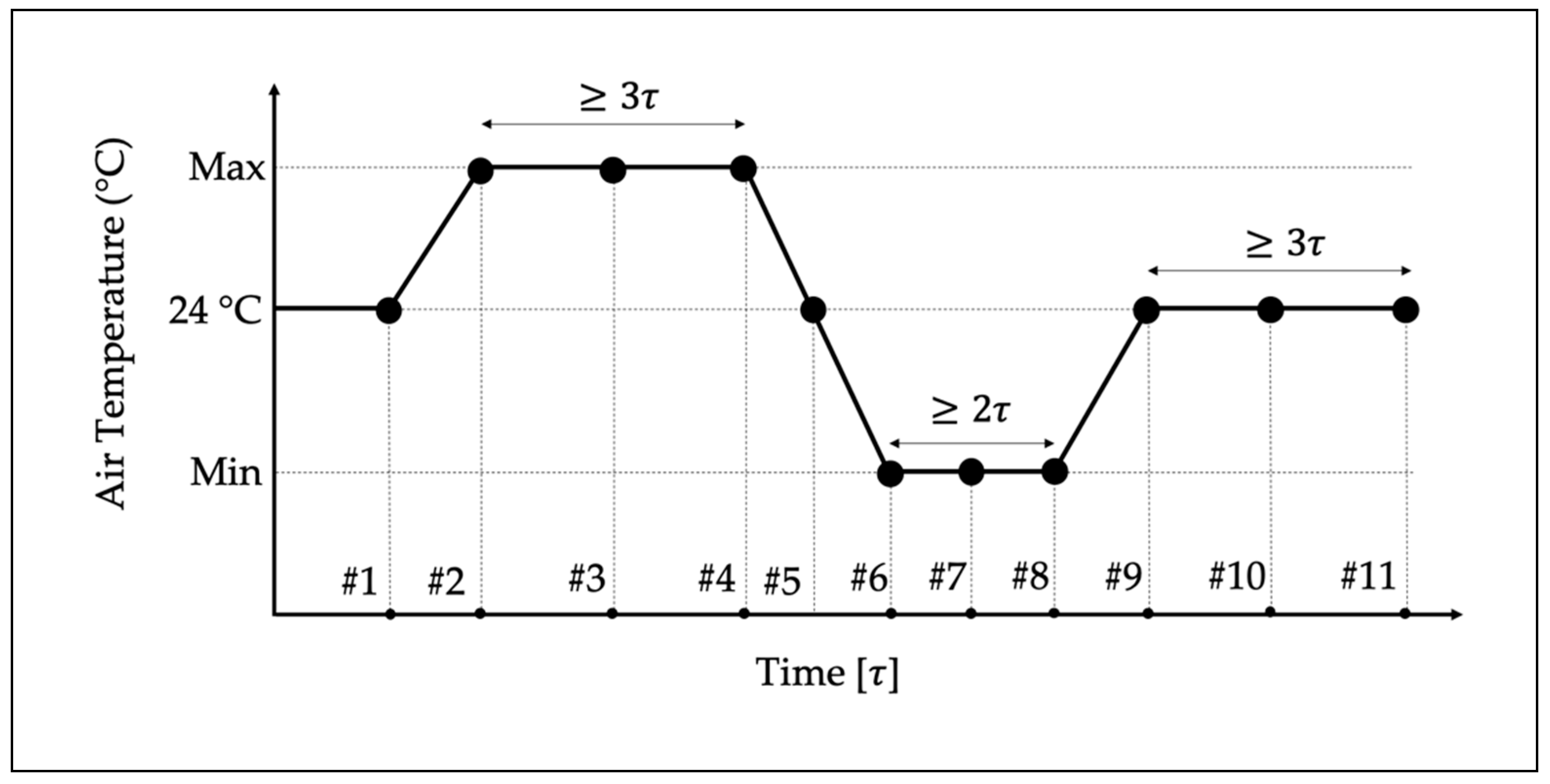

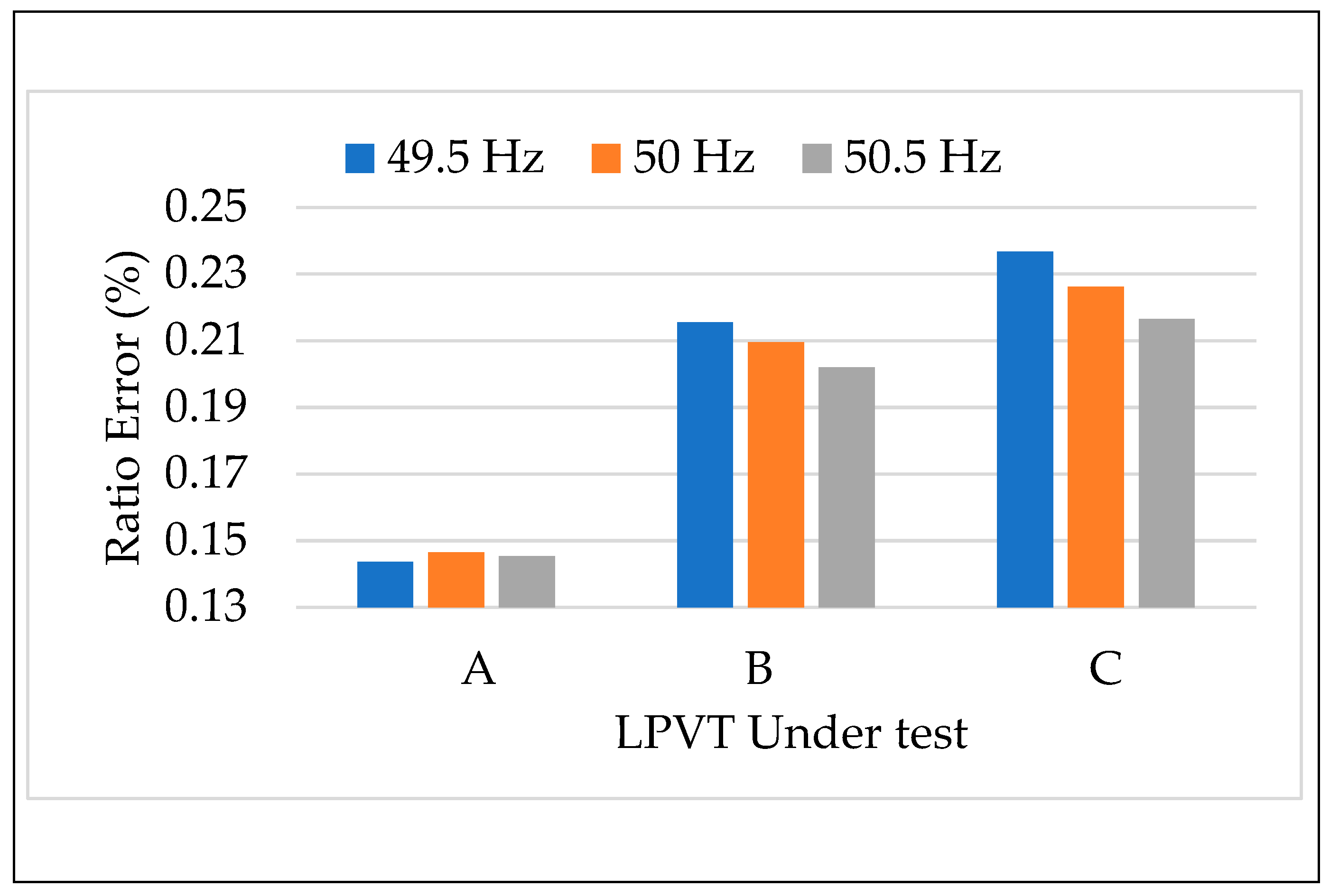
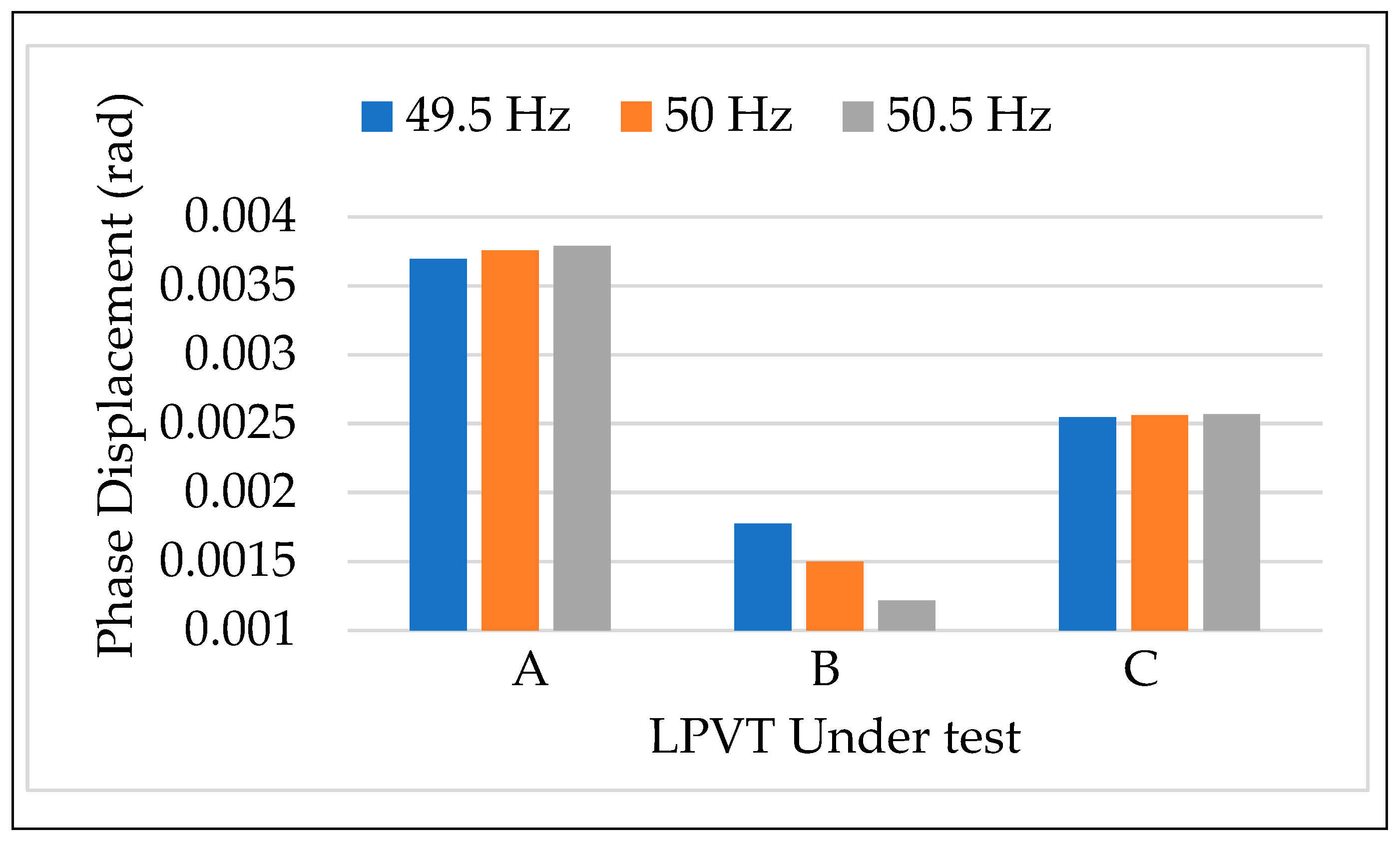

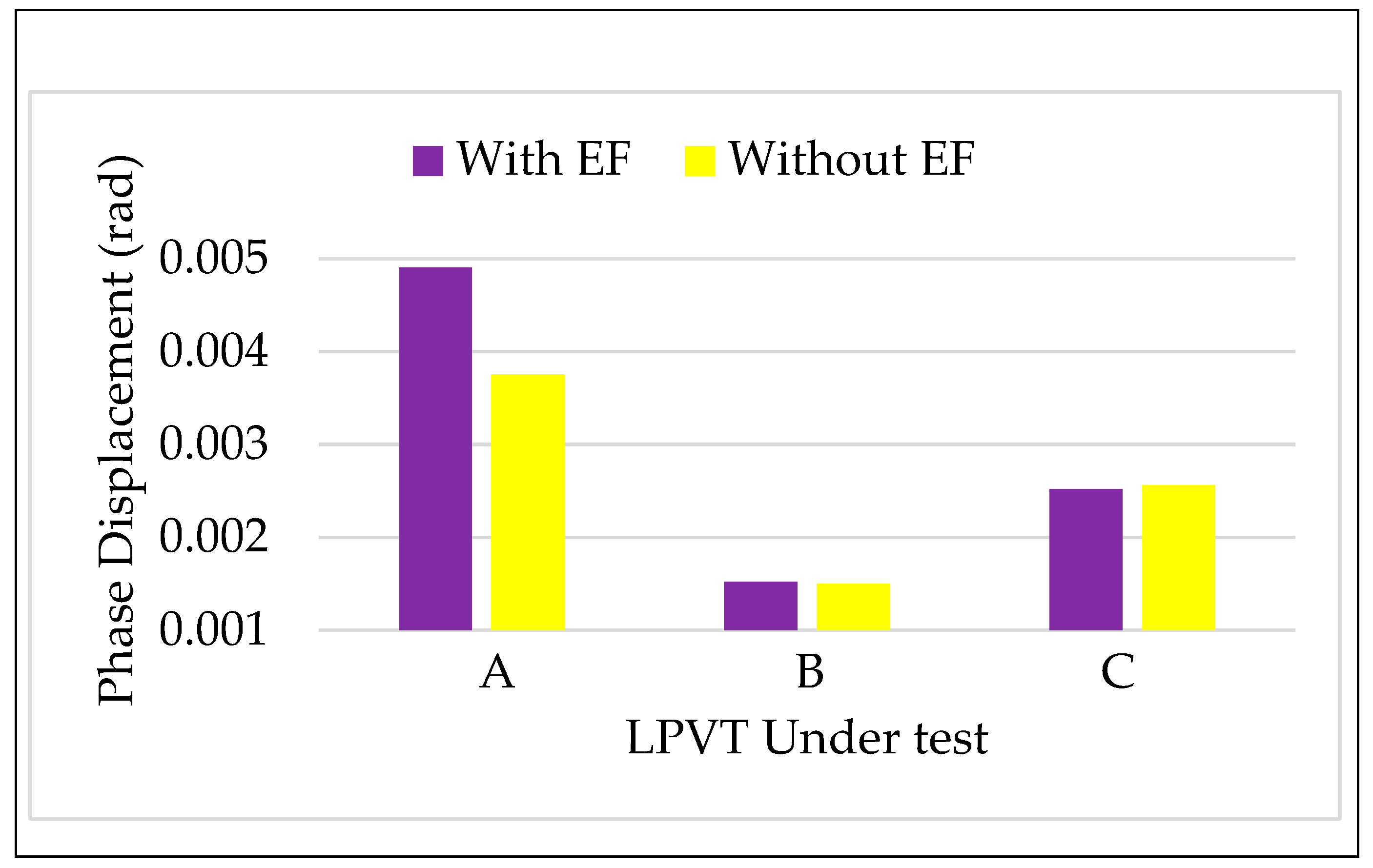
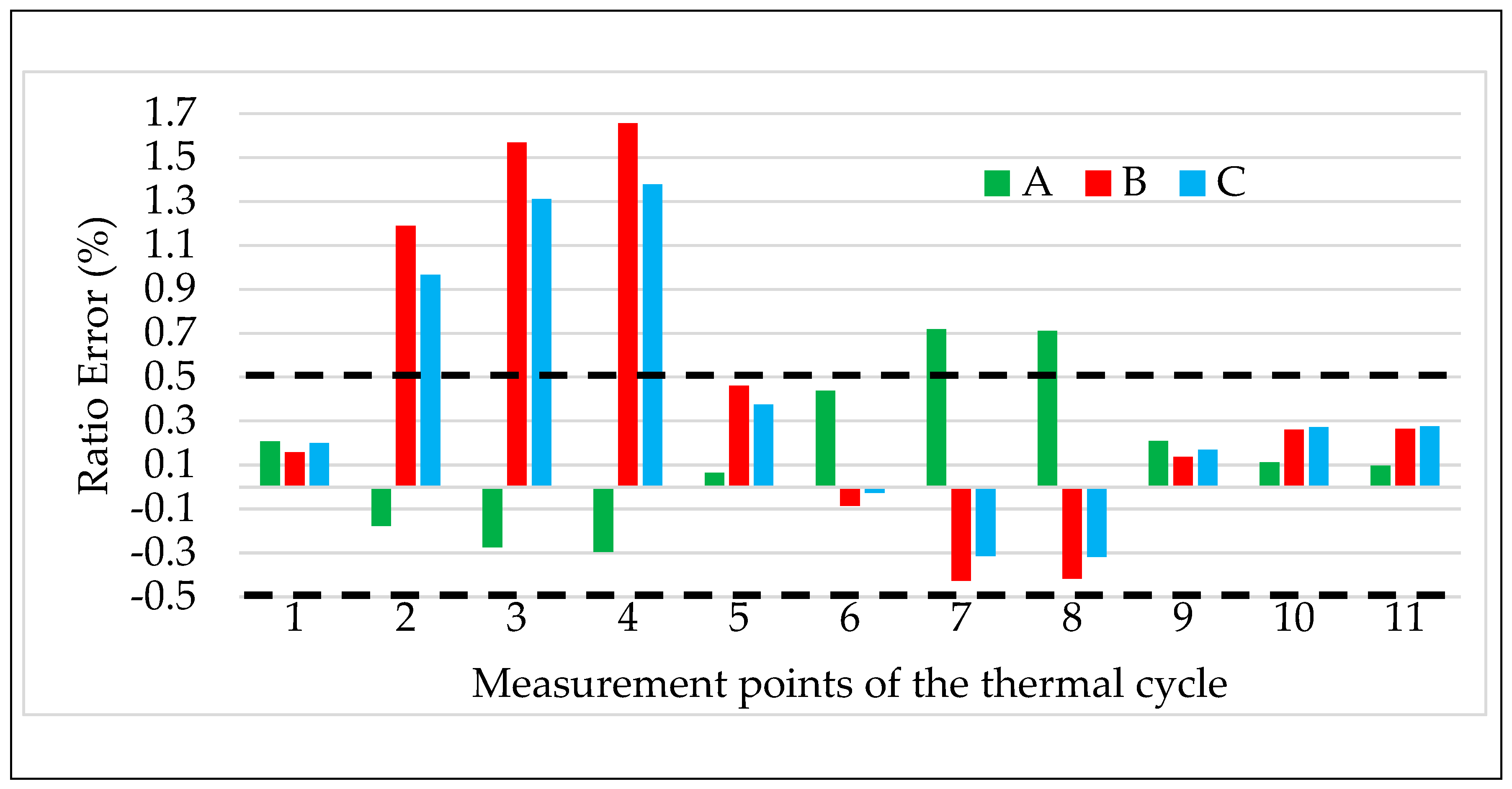

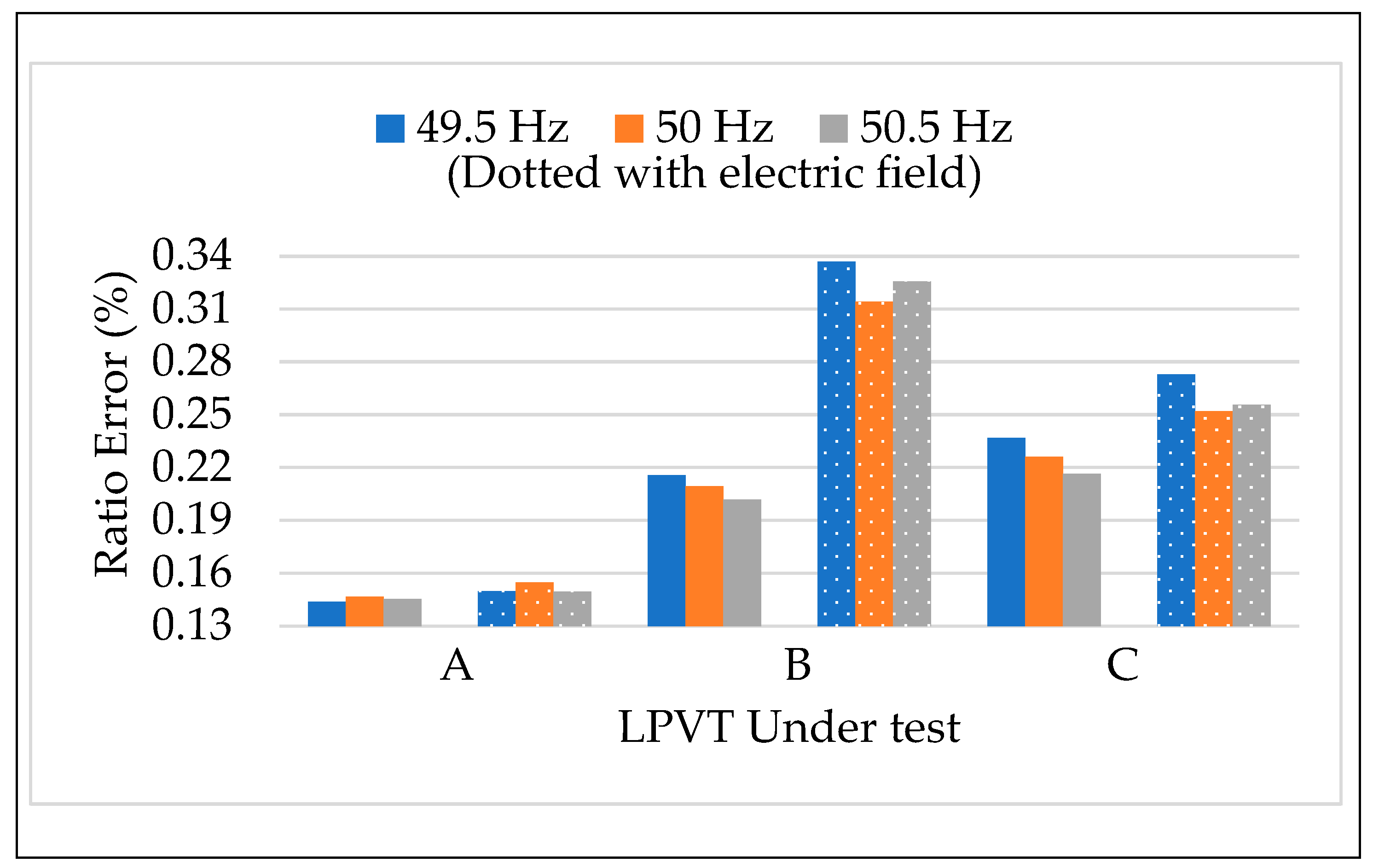



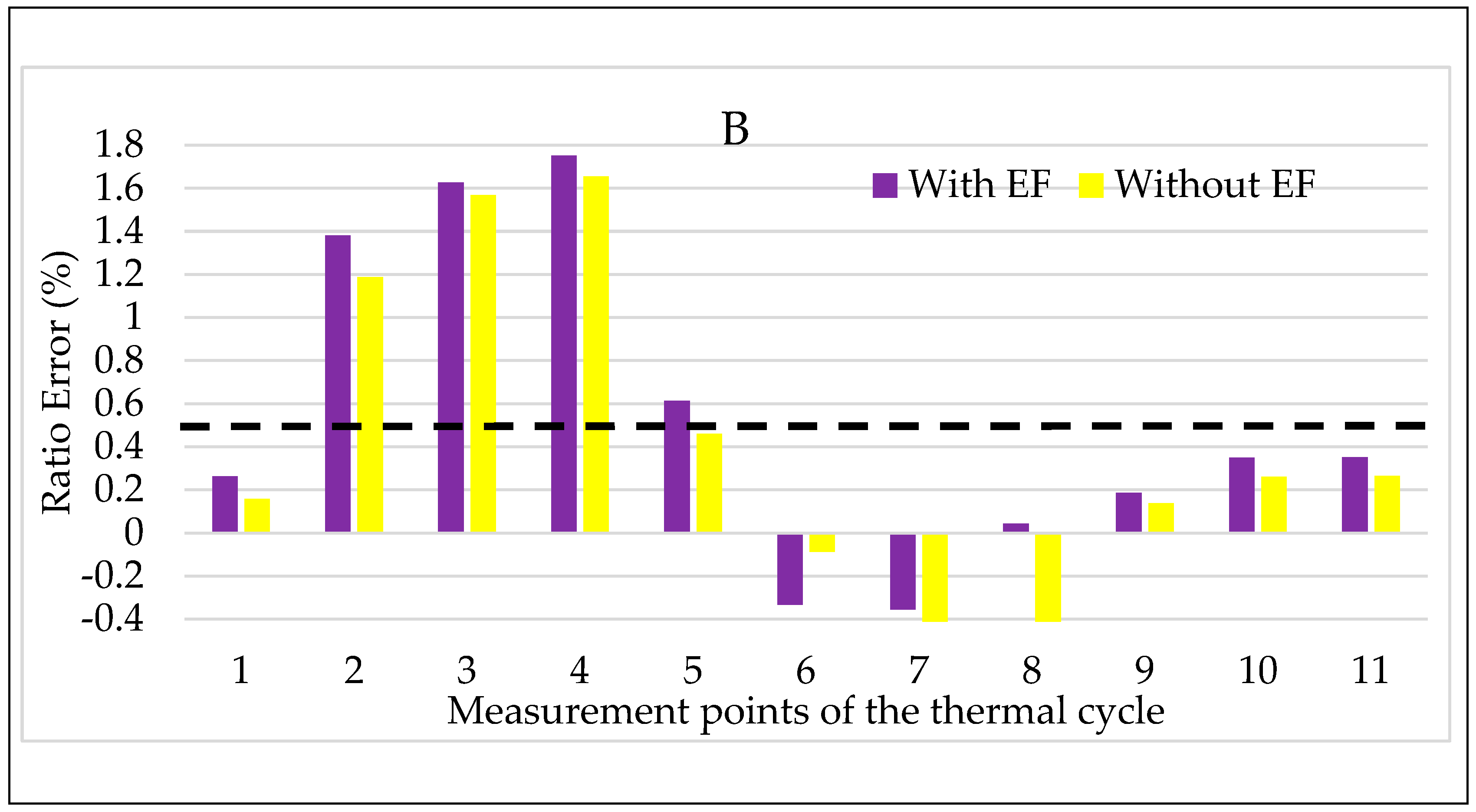
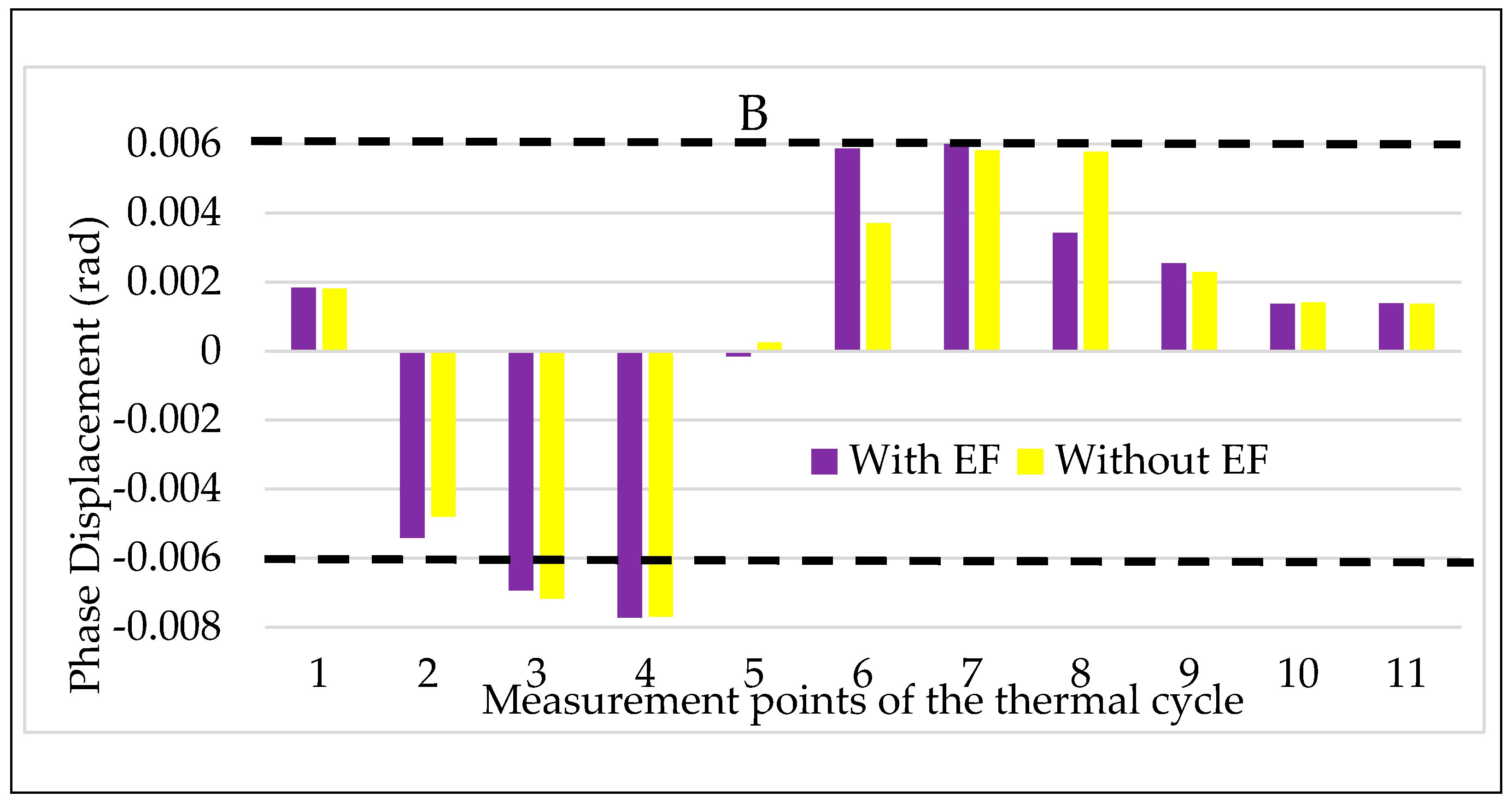
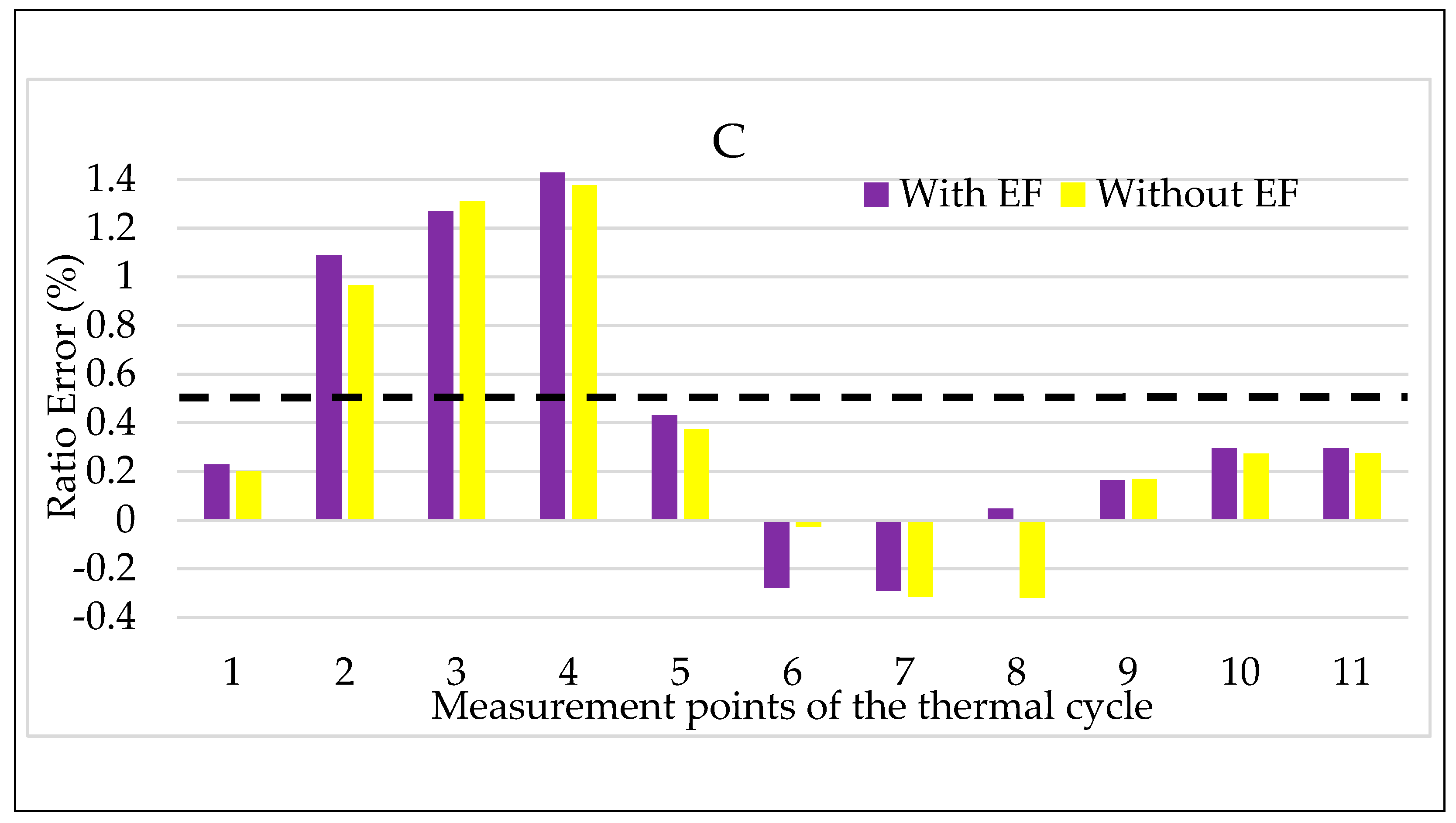
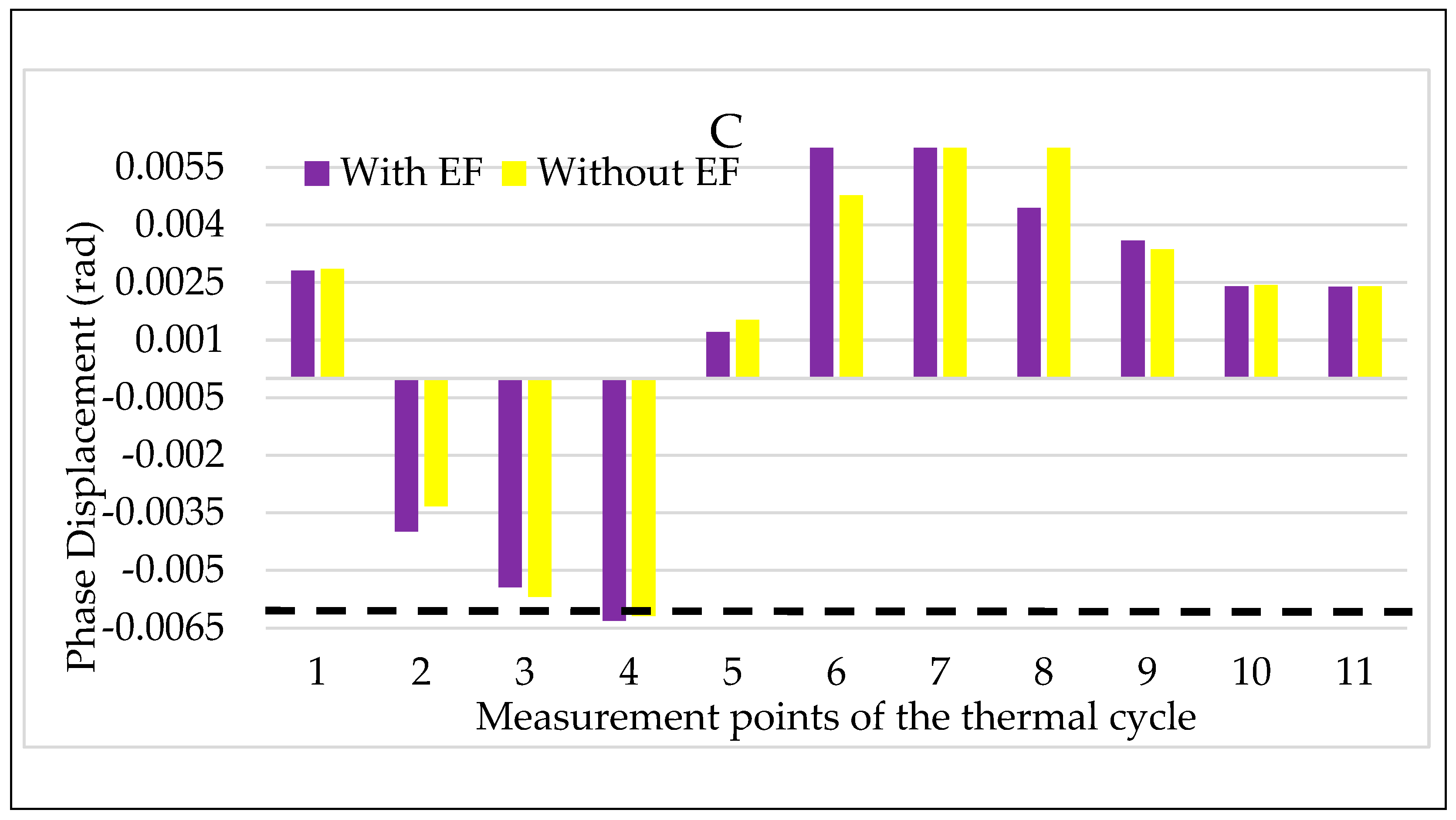
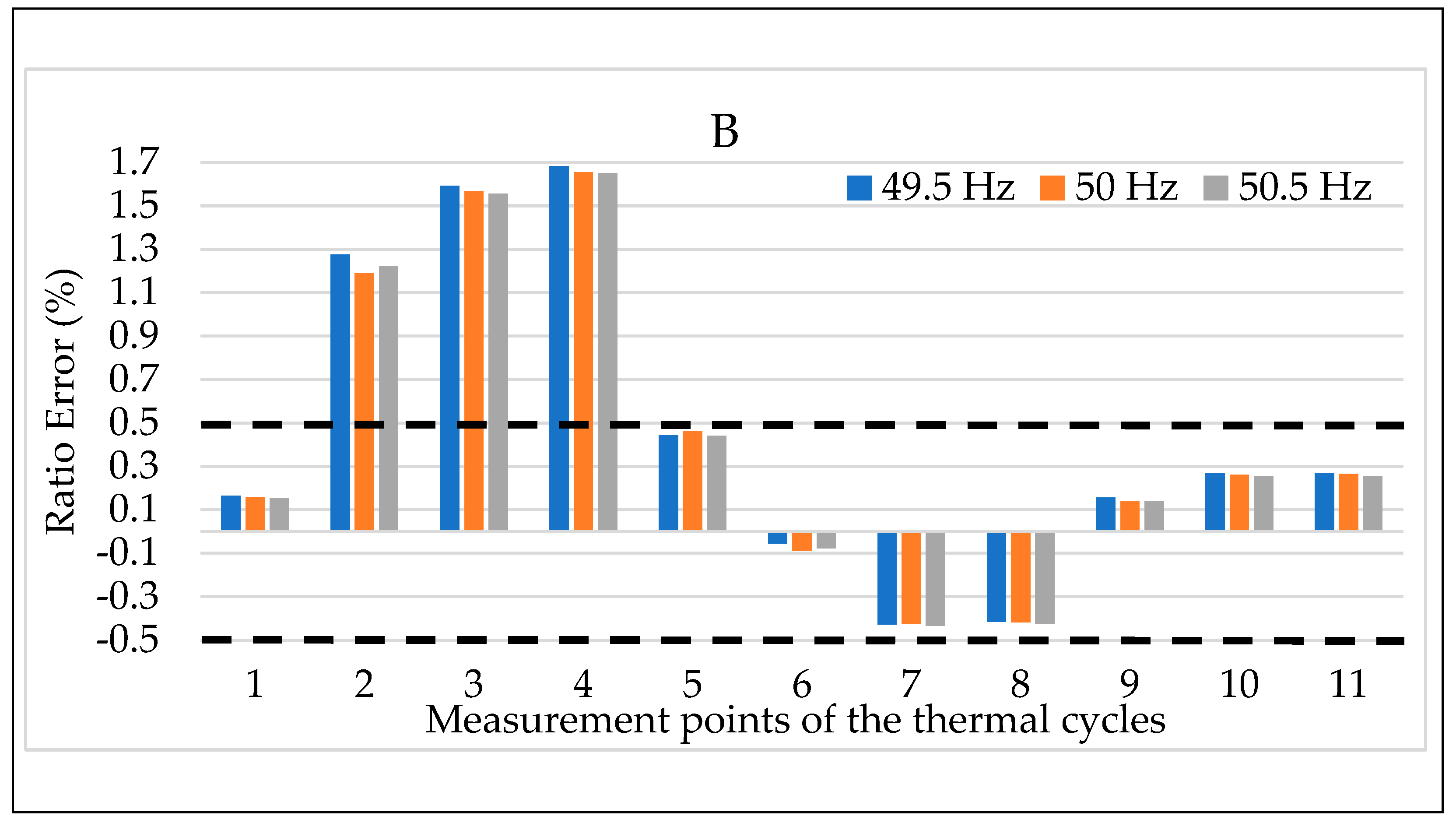
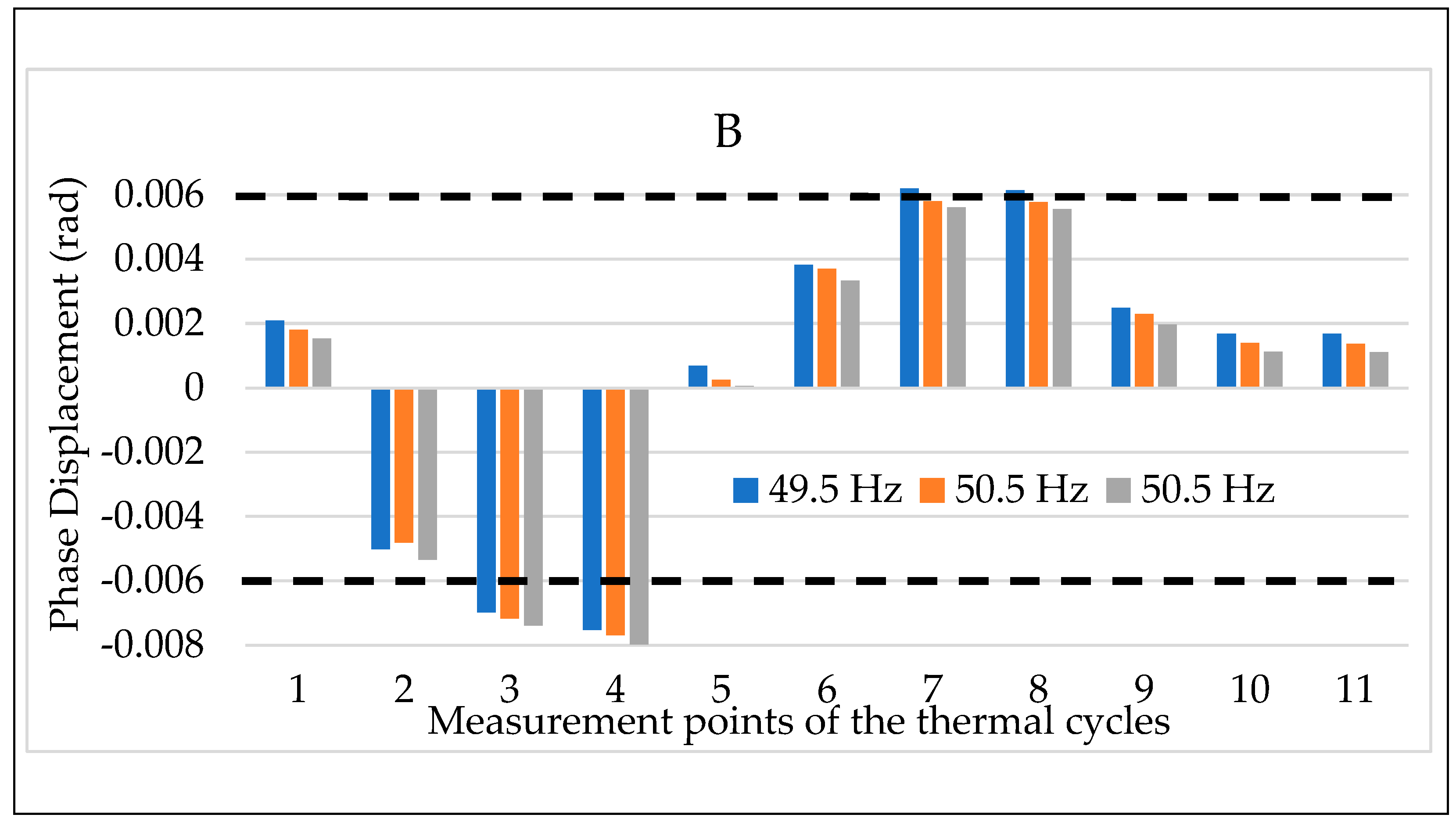
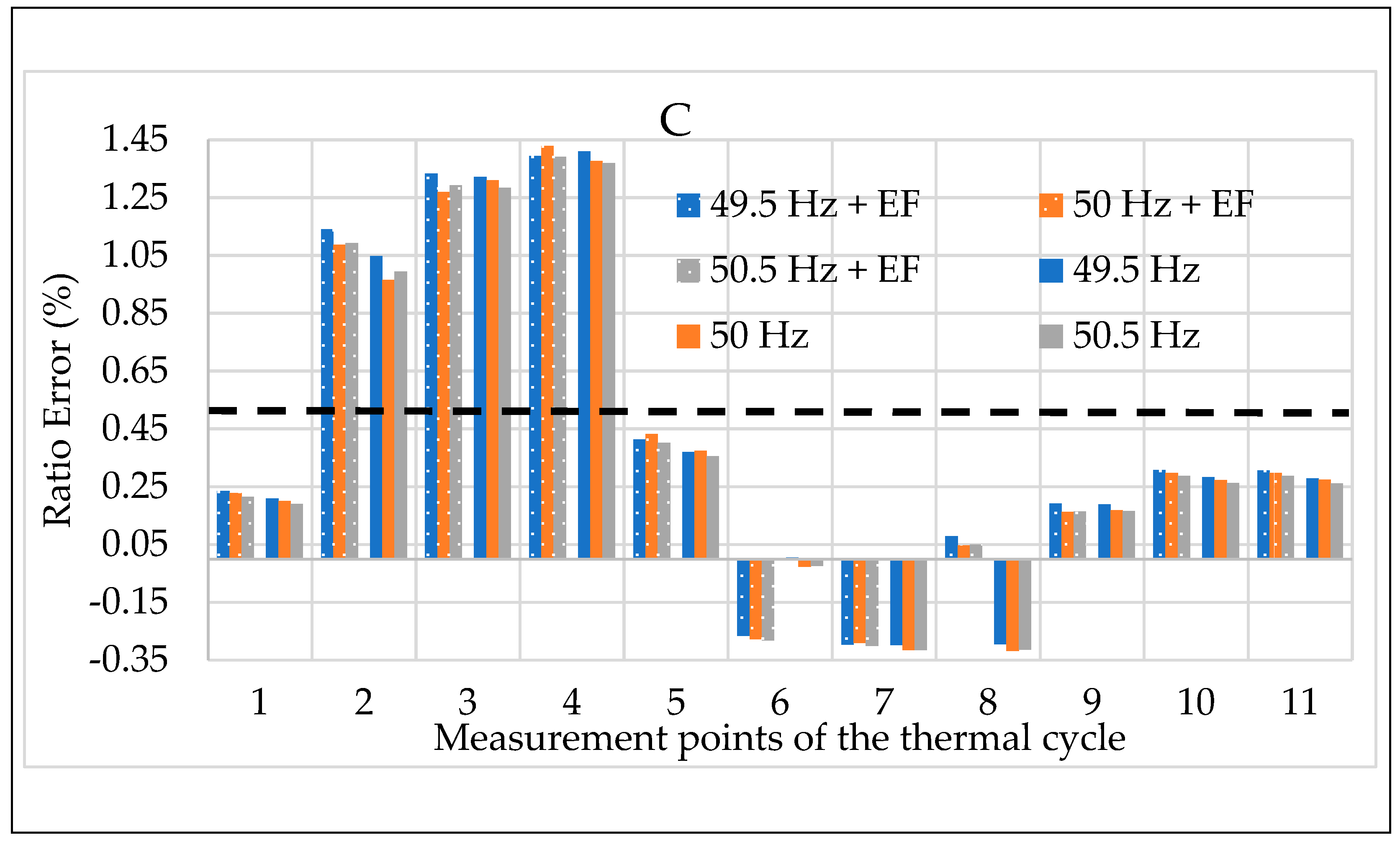
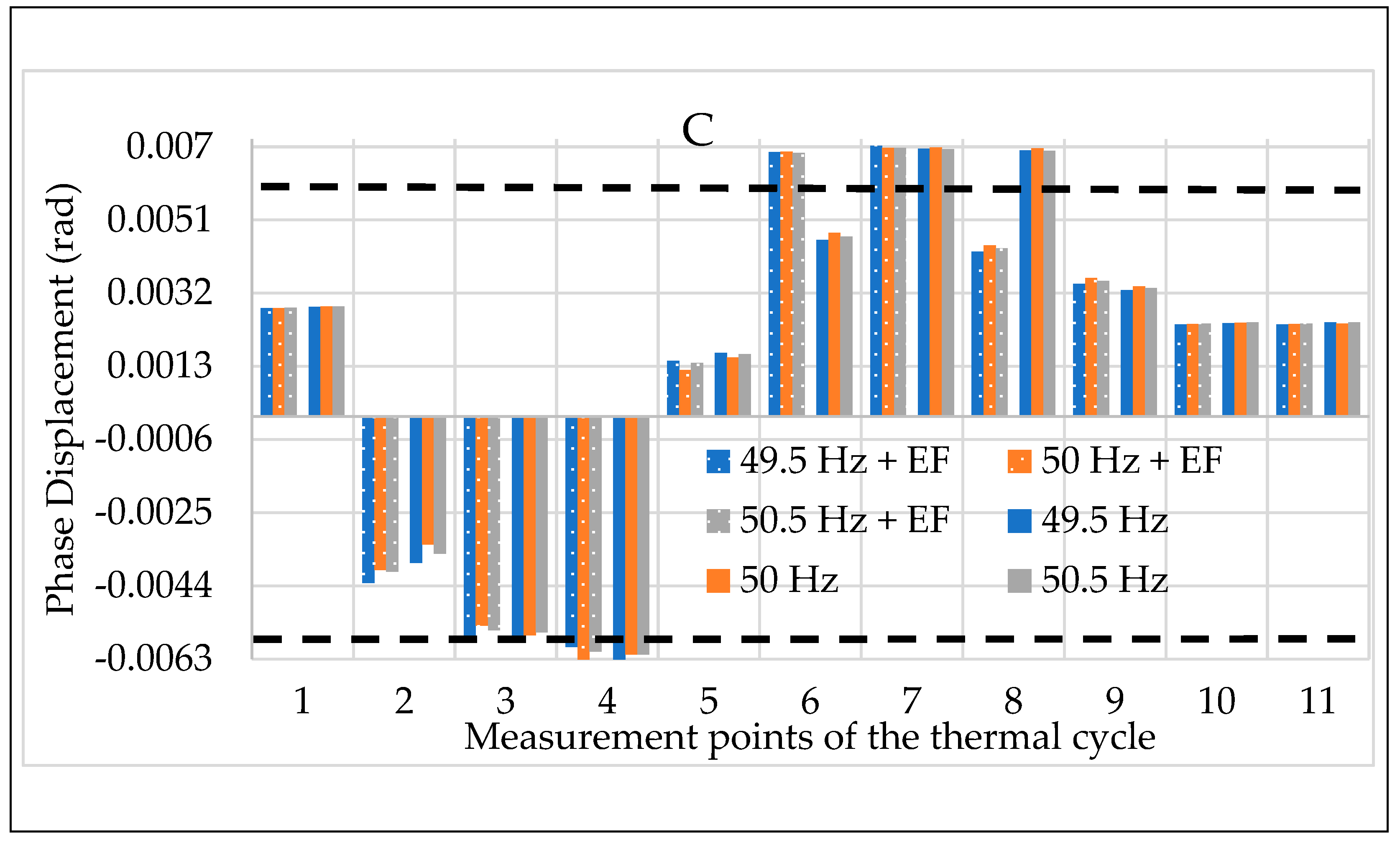
| LPVT | Type | AC | ||
|---|---|---|---|---|
| A | Resistive | 0.5 | ||
| B | Capacitive | 1.35 | 0.5 | |
| C | Active | 1 | 0.5 |
| LPVT | [%] | |||
|---|---|---|---|---|
| A | −0.0083 | 0.1 | −0.001 | 0.002 |
| B | −0.1047 | 0.1 | 0.000 | 0.002 |
| C | −0.0258 | 0.1 | 0.000 | 0.002 |
© 2020 by the authors. Licensee MDPI, Basel, Switzerland. This article is an open access article distributed under the terms and conditions of the Creative Commons Attribution (CC BY) license (http://creativecommons.org/licenses/by/4.0/).
Share and Cite
Mingotti, A.; Peretto, L.; Tinarelli, R. Calibration Procedure to Test the Effects of Multiple Influence Quantities on Low-Power Voltage Transformers. Sensors 2020, 20, 1172. https://doi.org/10.3390/s20041172
Mingotti A, Peretto L, Tinarelli R. Calibration Procedure to Test the Effects of Multiple Influence Quantities on Low-Power Voltage Transformers. Sensors. 2020; 20(4):1172. https://doi.org/10.3390/s20041172
Chicago/Turabian StyleMingotti, Alessandro, Lorenzo Peretto, and Roberto Tinarelli. 2020. "Calibration Procedure to Test the Effects of Multiple Influence Quantities on Low-Power Voltage Transformers" Sensors 20, no. 4: 1172. https://doi.org/10.3390/s20041172
APA StyleMingotti, A., Peretto, L., & Tinarelli, R. (2020). Calibration Procedure to Test the Effects of Multiple Influence Quantities on Low-Power Voltage Transformers. Sensors, 20(4), 1172. https://doi.org/10.3390/s20041172







